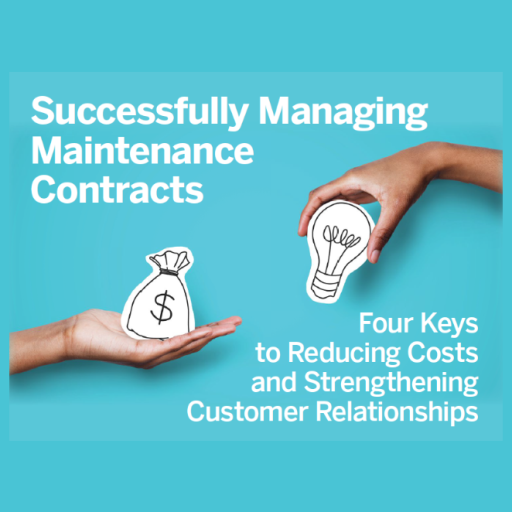Four Keys to Reducing Costs and Strengthening Customer Relationships
By Greg Mann and Steve Ross
Whether you call it full maintenance, comprehensive fleet maintenance or a myriad of other names, managing fixed-price maintenance contracts is critical to continued success for the dealer and customer. Let’s look at four ideas we used to reduce costs for the service provider and enable competitive contract pricing for the customer.
Bill Warranty or Bill Yourself
An often-underutilized cost-saving factor is the level of factory warranty support available to the dealer. Most manufacturers offer an additional warranty that will aid in cost reduction. Some have dealer support programs if units are enrolled in maintenance contracts to assist in long-term major component warranty. Other manufacturers offer additional warranty coverage that can be used to cover the costs of major component failures. Take advantage of any additional warranty coverage offered by the manufacturer.
After maximizing warranty coverage, the next challenge is ensuring the field utilizes the cost support program. Often, field technicians are unaware of a unit’s warranty coverage. They focus on operationalizing the unit, tracking their time, documenting their activity and rushing to the next call. Warranty status gets lost in the shuffle, causing some dealers to bill technician time to the customer when the unit is actually under warranty, or vice versa. The easier it is for the technician to identify the warranty coverage status, the better their chance of communicating and utilizing that coverage.
Partnering with Your Customer
Operator-induced repairs are viewed as a cost to the customer yet lead to unrecognized costs to the maintenance provider as well. When an operator damages a lift, the dealer bills the customer for the repair and believes the entire cost is captured. The unseen, downstream impact takes a toll on equipment that will not materialize for some time. The dealer will end up absorbing those costs.
A large office supply company we meet with quarterly to review costs began experiencing increasing “no fault found” service calls. Partnering with the facility’s operations manager, we discovered that most of these were down truck reports from the third shift. Focused oversight by the third shift supervisors confirming the truck was actually out of operation and in need of repair led to productivity increases and incident rates falling back to normal levels. Another partnership idea is sharing the cost of a customer safety incentive. That may be enough to reduce damage incidents, resulting in cost savings for the customer and dealer. Don’t be afraid to spend a little upfront to reduce costs in the future. Everyone wins, and the relationship with the customer will grow stronger.
Mindset Shift
Maintenance contracts come in all sizes, from large fleets requiring full-time technician support to smaller fleets managed on an as-needed repair basis. Dealers often think solely about parts and labor costs. Begin to think more holistically about costs by considering costs incurred at the very onset of a service request. 60% of the service calls we see are for units deemed operational. Sending a technician on a service request without all the required information leads to inefficiencies and added costs.
One distributor shared an invoice for $785 from a service provider for a trip charge and three hours of labor. The technician spent three hours determining who placed the service call and where the unit was located within the customer’s multi-building campus. Once he found the unit, he couldn’t replicate the issue or find a fault code. So he returned to his van, provided a detailed write-up and left.
Someone is incurring the cost of that inefficiency – either the dealer resulting in lower maintenance contract profits or the customer in terms of higher operating costs. Seek solutions to execute more effective pre-call planning to save the dealer time and money.
Improve Planned Maintenance Quality
The single most significant contributor to the cost of operating a fleet is the quality and detail of the planned maintenance (PM) program. If you want to strengthen your customer relationship and increase the full maintenance contract profitability, improve the quality of your planned maintenance program.
Every manufacturer publishes a planned maintenance schedule. This is a great place to start. An elite maintenance program will consider things not always specified in the manufacturer’s PM schedule. Examples include checking for loose wires, making minor adjustments before they become major problems and cleaning and painting the units. Maybe your motivation is to turn a full maintenance fleet from losing money to making a reasonable profit. The same quality maintenance program can be the answer. For over a year, we lost money on full maintenance contracts with a dairy processing facility. I was new to the industry then, so I was surprised when asked to take over the account and make it profitable.
I implemented the kind of maintenance program that I did on my vehicles and equipment with a “pay me now or pay me more later” mindset. In addition to all the factory required maintenance items, I looked at every repair with an eye toward what I could do on the PM to prevent that problem on all the units. A year later, the account was profitable and avoided increasing the maintenance contract price.
A quality maintenance program is and will always be the most critical factor in reducing cost per operating hour.
About the Authors
Greg Mann is a 30-year material handling veteran, starting as a technician and serving in multiple service leadership roles as he grew his career.
Steve Ross is a 40-year veteran of the material handling industry. Steve started his career as a technician and served in multiple leadership roles in sales, operations and service. He co-founded Hiver Quick Response, a software that increases machine uptime, reduces dealer WIP and increases technician productivity.




